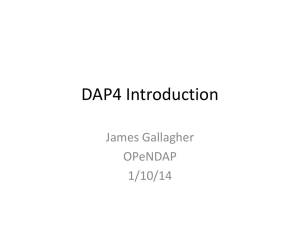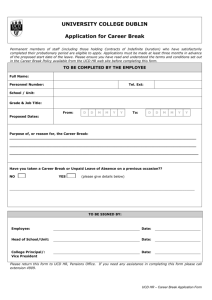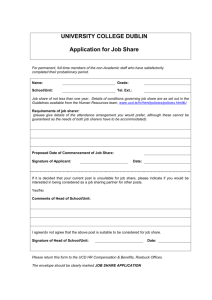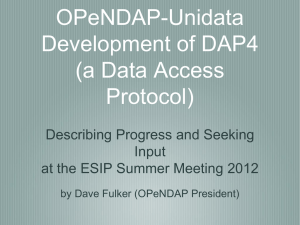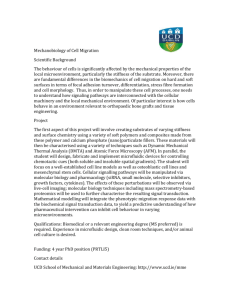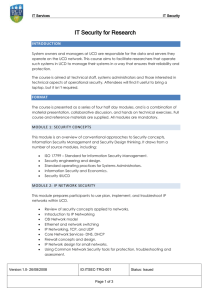Academic Council's Request for - Academic Senate, University of
advertisement
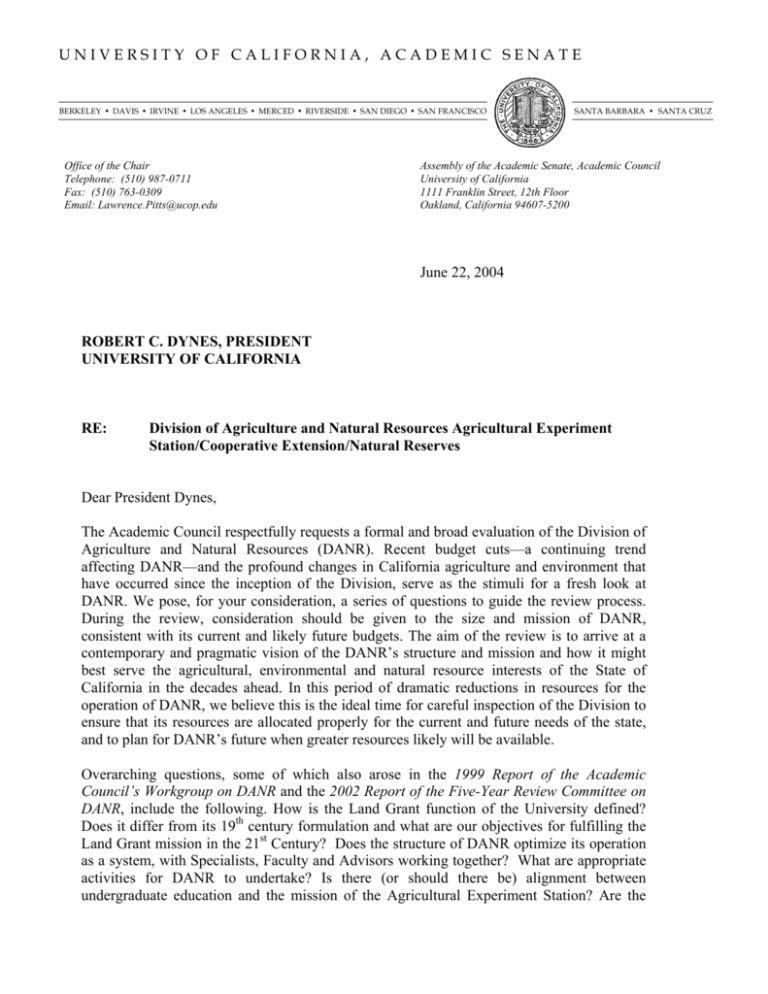
UNIVERSITY OF CALIFORNIA, ACADEMIC SENATE BERKELEY • DAVIS • IRVINE • LOS ANGELES • MERCED • RIVERSIDE • SAN DIEGO • SAN FRANCISCO Office of the Chair Telephone: (510) 987-0711 Fax: (510) 763-0309 Email: Lawrence.Pitts@ucop.edu SANTA BARBARA • SANTA CRUZ Assembly of the Academic Senate, Academic Council University of California 1111 Franklin Street, 12th Floor Oakland, California 94607-5200 June 22, 2004 ROBERT C. DYNES, PRESIDENT UNIVERSITY OF CALIFORNIA RE: Division of Agriculture and Natural Resources Agricultural Experiment Station/Cooperative Extension/Natural Reserves Dear President Dynes, The Academic Council respectfully requests a formal and broad evaluation of the Division of Agriculture and Natural Resources (DANR). Recent budget cuts—a continuing trend affecting DANR—and the profound changes in California agriculture and environment that have occurred since the inception of the Division, serve as the stimuli for a fresh look at DANR. We pose, for your consideration, a series of questions to guide the review process. During the review, consideration should be given to the size and mission of DANR, consistent with its current and likely future budgets. The aim of the review is to arrive at a contemporary and pragmatic vision of the DANR’s structure and mission and how it might best serve the agricultural, environmental and natural resource interests of the State of California in the decades ahead. In this period of dramatic reductions in resources for the operation of DANR, we believe this is the ideal time for careful inspection of the Division to ensure that its resources are allocated properly for the current and future needs of the state, and to plan for DANR’s future when greater resources likely will be available. Overarching questions, some of which also arose in the 1999 Report of the Academic Council’s Workgroup on DANR and the 2002 Report of the Five-Year Review Committee on DANR, include the following. How is the Land Grant function of the University defined? Does it differ from its 19th century formulation and what are our objectives for fulfilling the Land Grant mission in the 21st Century? Does the structure of DANR optimize its operation as a system, with Specialists, Faculty and Advisors working together? What are appropriate activities for DANR to undertake? Is there (or should there be) alignment between undergraduate education and the mission of the Agricultural Experiment Station? Are the current DANR priorities reflective of the Cooperative Extension and Research missions of the division, or is there too much emphasis on basic research not directly related to agriculture and natural resources? Are principles of shared governance in place to allow faculty to communicate effectively with DANR administration? What is the role of DANR in the teaching, research and public service missions of the University of California today and how will it serve the public interests of the State of California in the years ahead? What is the Long-Range Development Plan? The following specific questions or areas of inquiry should be addressed in the review: • Are DANR’s size and function optimum? What are appropriate missions for the Agricultural Experiment Stations (AES) and Cooperative Extension (CE)? How do the missions of the AES and CE align with, or diverge from, those of the University of California? What course of action can best achieve the broad mission of AES and CE? The review should include consideration of current and projected economic drivers and the political landscape of the state. • How do and how should the Specialists, Faculty and Advisors interact? Are the current coordinating apparatuses as workgroups and program committees effective and appropriate? Is there need for reexamination of the role of professional staff, AES faculty, CE Specialists, and CE Advisors? Should the Cooperative Extension Specialists be in an “equivalent” series (like Agronomists)? Should joint professorial appointments be encouraged? • How does DANR’s research align with the research needs for agricultural and natural resources of the State? Is the University appropriately committed to agricultural and natural resources disciplines? Does it contribute to the agricultural industry? Does it foster best uses of natural resources and promote the public health in the realms of environmental protection, transportation, among others? How much of the research is and should be basic science and how much contributes to more applied missions? How can a commitment to mission-oriented activities foster development of education and research programs in corresponding, broad-based disciplines? What research topics properly belong in the public and private sphere? For instance, should UC continue to breed new plant varieties? Is there appropriate emphasis on entomology and plant pathology? What should UC's role be in research in the environment and associated policy? What is the role of DANR in the management of the State’s natural reserves? • What are the appropriate undergraduate and graduate teaching programs of the Agricultural Colleges, for both agricultural and natural resources disciplines? How many students are in agricultural sciences, environmental science, business and nutrition? How best does the teaching program align with the AES mission? Where do the agricultural, natural resources and environmental science industries recruit from, and where do the agricultural colleges place their students? What are the educational roles of AES with respect to the number of students doing research, the number of students supported as GSRs, the number of faculty supporting dissertations, and the role of graduate students in extension stations? What is the status of the teaching facilities? 2 • What is the most effective and efficient administration of DANR—centralized, or decentralized to local AES campuses? What structure supports the most efficient use of resources—FTE, space and support dollars? What structure best facilitates rapid responses to new funding opportunities or the launch of new initiatives? • How much of the work of AES should be done by the local AES campuses, and what role(s) do the non-AES campuses play? Has there been reconsideration of the manner whereby DANR funds are managed and how research money is awarded? What are the best mechanisms to broaden the UC community of major research contributors to the DANR mission? What is the budgetary feasibility of involving other units? Has there been careful consideration of the best use of all DANR resources, including the endowments? • What will be the mission and role of the AES and CE vis-à-vis the current budget climate—in recognition of the 25 and 30% cuts to AES and CE, respectively, in the past two years? What has been the budgetary history of AES and CE in the last 30 years? What should be the mission of the AES and CE now and five and 10 years from now? • What is the most appropriate and useful role for the Academic Senate to play in DANR? A large number of UC faculty members share joint appointments through the AES and UC departments. Other UC employees do not have faculty status, but are very important members of DANR. This should be reviewed to ensure that job titles appropriately represent the work of DANR participants. Given DANR’s substantial budget part of which supports major research efforts, what is the most appropriate review process for agricultural and natural resources research, and how best can the Academic Senate participate in meaningful and productive reviews? What formal mechanisms can be implemented for Faculty to provide advice about UC’s ANR programs, and to ensure the consistency of shared governance in ANR as in other UC teaching and research programs? • What is the role of the 4H program? What support does the University give to that program and what support comes from outside the University? Does this program align with the mission of the University of California? Are there environmental advocacy groups that UC should encourage or support? The Academic Council strongly recommends the appointment of a Blue-Ribbon Review Panel to consider optimization of the mission and organizational structure of AES and CE over the next 5-10 years and beyond. We believe this review should be directed by experts in education and research in agriculture and natural resources, include reviewers both from within and outside UC, and be led by a prominent academician (probably compensated) from outside the Land Grant structure and from outside the administrative structure of DANR. The Panel should reflect a broad range of interests and expertise, including educators in agriculture and natural sciences, agribusiness, county and state governments, small farmers, and consumers. The Academic Council does not believe that the ANR “listening sessions” held at several sites across the state by DANR administration this past winter will allow the careful, dissociated and requisite objective examination of the organization and mission of DANR to arrive at a new plan to best serve the interests of the University and the State of 3 California in agriculture, environmental sciences, natural resources, human resources and the natural reserves. The Academic Council would be pleased to discuss this with you directly if you have questions or concerns about the background leading to this letter, or if you would like further clarification of specific questions raised above. Cordially, Lawrence Pitts, Chair Academic Council Copy: Encl.: Academic Council 1 4 Possible UC faculty members to serve on the Blue Ribbon Panel Suggestions from Academic Council workgroup on DANR Review Gary Anderson (UCD) David Ashley (UC Merced) Peter Berck (UCB) George Bruening (UCD) Ted DeJong (UCD) Kathryn Dewey (UCD) Charles Hess (UCD emeritus) Andre Lauchli (UCD) Alexei Marradudin (UCI emeritus) Bill Oldham (UCB) Khaw Tha Paw U (UCD) John Quigley (UCB) Robert Rucker (UCD) Irwin Sherman (UCR) Hal Varian (UCB) Julian Aston (UCD) Tom Campbell (UCB) Andrew Grosovsky (UCR) JaRue Manning (UCD) Shmuel Oren (UCB) Justin Roberts (UCR) Sam Traina (UCM) Suggestions from Academic Council members: Martin Yanofsky (UCSD) Keith Gilles (UCB) Robert Goldberg (UCLA) Brent Haddad (UCSC) Ann Hirsch (UCLA) Warren Johnston (UCD) Janet King (UCB) Deborah Letourneau (UCSC) Steven Lindow (UCB) Alex McCalla (UCD) Sabeeha Merchant (UCLA) Gordon Rausser (UCB) Jim Reichman (UCSB) Philip Rundel (UCLA) Robert Schmidt (UCSD) Julian Schroeder (UCSD) Richard Sexton (UCD) Carol Shennan (UCSC) Victoria Sork (UCLA) Martin Yanofsky(UCSD) Possible external faculty to serve on the Blue Ribbon Panel Suggestions from Academic Council members: Elton Aberle, Dean, College of Agriculture and Life Sciences, U Wisconsin and Chair, Academic Heads Section of the National Association of State Universities and Land Grant Colleges (NASULGC) Rick Amasino, Professor, Biochemistry, U Wisconsin Dan Arp, Professor and Chair, Botany and Plant Pathology, Oregon State University\ Chris Fields, Professor, Standford Steve Huber, Professor, Crop Science, North Carolina State University Brian Larkins, Professor, Plant Sciences, University of Arizona Hal Mooney, Professor, Standford Professor Gordon Orians, Professor, University of Washington Donald Ort, Professor, Plant Molecular Biology and Physiology, U Illinois – Champagne Urbana Robert Pain, Professor, University of Washington Hal Salwasser, Dean, College of Forestry, Oregon State Univ, and former US Forest Service wildlife biologist, Experiment Station Director and Regional Forester 5
